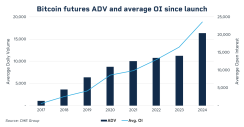Ivan Castano, for CME Group
AT A GLANCE
- Following the approval of spot bitcoin ETFs, more traders and investors are moving to mitigate risks in the futures market
- The introduction of spot ETFs makes “the ecosystem more robust,” says ProShares analyst
Indeed, open interest in CME Group Bitcoin futures hit an all-time-high on January 12, the day U.S. regulators approved 10 new Bitcoin spot ETFs for trading, enlarging the space beyond Bitcoin futures.

Moreover, an average of 66,000 Bitcoin futures contracts changed hands daily in the same month, representing a nearly 50% jump month-on-month and surpassing their previous high in November 2022, according to CME Group data.
“We see regulation as a feature, not a bug,” says Giovanni Vicioso, Global Head of Cryptocurrency Products at CME Group, underscoring that futures are a regulated marketplace, while spot crypto is not. “This has attracted a global, diversified mix of institutional and sophisticated investors to our marketplace.”
As the highly volatile, $1.95 trillion crypto market reaches its next development phase, traders and investors are moving to mitigate risks and find arbitrage opportunities between the value of futures contracts and Bitcoin’s real-time price. Meanwhile, the so-called cash and carry trade, a popular trading strategy among Chicago-based traders, is also gaining in popularity, according to analysts.
Price Rollercoaster
Speculation about the new ETFs’ approval reached a crescendo in the days before the SEC cleared their trading, sending Bitcoin prices surging to a hair under $47,000. However, in an unexpected turn of events, prices plunged roughly 15% soon after they hit screens, sending a slew of other digital assets and “Bitcoin proxies” such as Microstrategy and Riot Blockchain, into a tailspin.On February 13 however, Bitcoin roared back to life, surpassing $50,000 and moving closer to its $64,400 all-time high achieved in November 2021, underscoring the asset’s notoriously volatile nature.
Analysts attributed the recent performance to an influx of new money into the fledgling ETFs which have netted $3 billion since launch. Inflows have so far been underwhelming, at least against some of the most bullish estimates, which put them at $100 billion for this year.
“Nice Step Forward”
Simeon Hyman, Global Investment Strategist at ProShares, said the spot ETFs will help strengthen the market as it girds up for Bitcoin’s halving event which some predict could send the token to new heights.“It’s a nice step forward,” Hyman told Vicioso in a recent interview for the OpenMarkets Exchange of Ideas video series. “More regulatory approval of spot Bitcoin ETFs makes the ecosystem more robust.”
In 2021, ProShares launched the first bitcoin-linked ETF, Bitcoin Strategy (BITO) which invests in Bitcoin futures. The spot fund arrivals will also help build a more robust derivatives market, says Hyman.
“One of the ironies we have seen is that the futures market has become more efficient thanks to the launch of spot-market ETFs,” he said, adding that the new asset class has also helped draw a more diversified trader and investor pool to crypto futures markets. “Premiums have actually come down...We are still at 5%-plus Fed funds [rate]. They don’t need to get to zero but they are coming down and that is important.”
BITO’s ETF is also benefiting from the trend.
“There are robust options on BITO and that is important to ensure that the ecosystem is efficient and that different voices are speaking to one another through that price mechanism.”
Bitcoin Halving
Hyman said Bitcoin’s halving, in which the token miners’ compensation will be slashed by about 50% - could be a bullish catalyst.The event, set for April 22, will cut producer’s pay to 3.125 BTC from 6.25 BTC currently. This will cut Bitcoin’s supply while boosting innovation (as miners’ with higher energy costs and less efficient hardware could struggle) in the crypto sphere, advocates say.
“The halving event is coming up and it’s a big thing that has been historically bullish for BTC,” Hyman noted. But the ETFs have also brought a much-needed endorsement for the space, he added.
“Bitcoin has done what it is expected to do: become a diversifier or, in other words, the zig to the zag. More folks are seeing that a little sprinkle [of Bitcoin] into a regular asset allocation can generally make for an efficient portfolio.”





